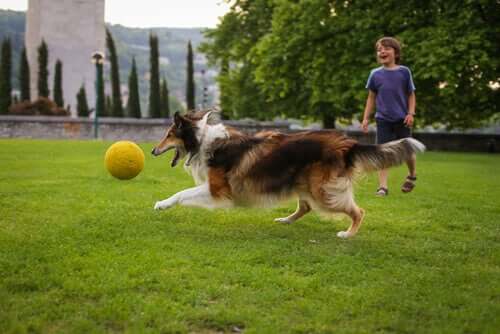Dogs in Classrooms Can Help Children Learn


Written and verified by the lawyer Francisco María García
Dogs are not only man’s best friend, but they can also be a child’s best friend. They’re a buddy that children can depend on. The benefits that animals, and especially dogs, can offer for children are many and varied. That’s why dogs are playing a widening role in teaching methods and in therapy treatments. It’s becoming increasingly common to see dogs in classrooms.
Dogs in classrooms can provide support for all children

The treatments that most commonly use dogs are therapy treatments for children with autism spectrum disorders (ASD). Dogs can also help children with mobility impairments, Down syndrome and those who experience difficulties with social interaction. They’re also helpful to children who need help managing their aggression or anger.
However, it is becoming increasingly common to see dogs in classrooms helping to teach children who don’t have any particular condition.
According to specialists who encourage the use of dogs in classrooms, dogs help children improve their concentration and make learning more fun. Bringing dogs into the classroom can really benefit certain aspects of learning, such as reading and understanding numbers.
Dogs in classrooms can reduce stress in children
Several studies have played a key role in dogs being successfully introduced into classrooms as a teaching aid. These studies have shown that dogs dramatically reduce stress in children.
Certain situations that can generate a lot of stress for a child can become bearable and perfectly manageable when a dog accompanies the child in question. These are common situations such as speaking in public or sitting an exam.
The same is true for children with special needs. In these cases, the results are very noticeable.
Helping children integrate into their environment
Dogs have been used in schools quite frequently since the mid-90s. They can help autistic children interact with their surroundings and socialize. They can also improve children’s general quality of life (and that of their relatives).
Dogs can do this by helping children to deal with new experiences, such as starting school, which can also be quite stressful.
The benefits for children
Here are some of the many benefits highlighted by specialists who use dogs in therapy treatments for autistic children:
Decreasing “escape behavior”
This is a hidden risk that parents and those who look after children with ASD must face. Dogs are trained to physically block a child’s path if they try to run or escape
When a dog accompanies a child with ASD when they go outside or go to school, the child wears a belt secured to the dog. If the child tries to run away, their dog will lay down on the ground. Over time, specialists say that this type of behavior will decrease until it stops completely.
Promoting tolerance and managing frustration
In general, dogs promote tolerance and help with managing frustration. When a child with autism finds themselves in a situation that they find unpleasant or that makes them anxious, they often respond by screaming or crying.
They can also exhibit other stereotypical behavior, such as violent hand movements. When these children spend time around dogs, these types of stress-induced reactions steadily become less frequent.
Encouraging communication
It’s common knowledge that verbal interaction can be almost impossible for people with autism. However, through working with dogs, children can steadily start to maintain visual contact with those around them. They can also start to communicate in other verbal and non-verbal ways.
Broadly speaking, dogs can really motivate children. They can help them develop their social skills, as well as their attention span, concentration and self-esteem. Specialists recommend that children should start working with the dog assigned to them as early as possible, preferably when they’re around 3 years old.
Other roles in therapy and teaching

Dogs often accompany children with mobility impairments when they go to school. They become more than just their assistants.
Many dogs, and especially those who are trained for this purpose, are very fond of children. In general, children can also easily build strong relationships with animals. We can start to see some perhaps surprising results by making the most of the protective, team instinct, as well as the natural empathy, that is shared between children and dogs.
This text is provided for informational purposes only and does not replace consultation with a professional. If in doubt, consult your specialist.